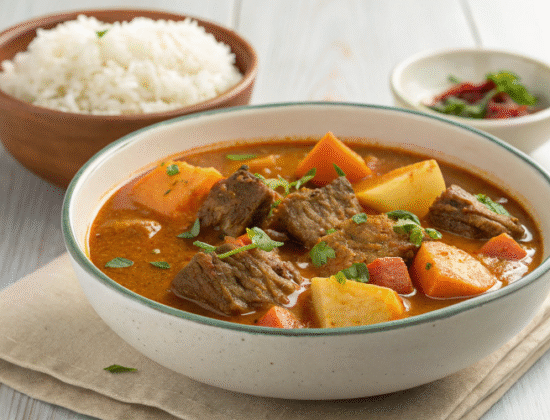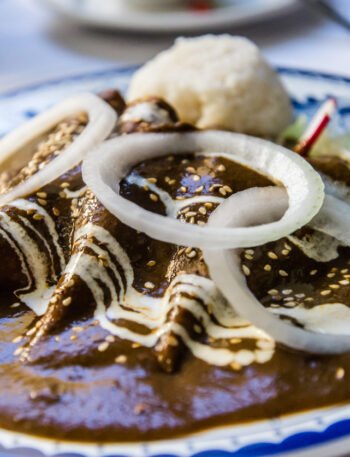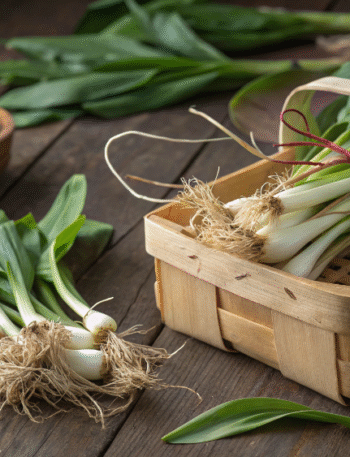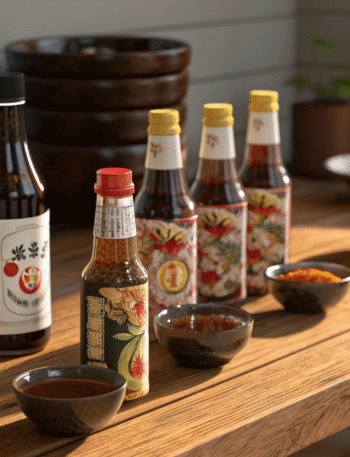I’ve been lucky to spend a lot of time in Guatemala, especially in and around Antigua, where I have a strong extended family. Over the years, they’ve welcomed me into their homes and kitchens, introducing me to a wide range of local dishes. From tamales and chiles rellenos to hilachas and jocón, Guatemalan cuisine is rich, layered, and full of surprises. But out of all the foods I’ve come to love, pepian is one that really stands out.
Pepián is more than just a meal. It’s a window into Guatemala’s history, culture, and family traditions. It’s one of the oldest dishes in the region, and it holds the special honor of being Guatemala’s national dish. Whether served at a casual lunch or during a special celebration, it brings people together. For me, it’s a favorite not just because of how it tastes, but because of the memories and connections it represents.
So, What Exactly Is Pepián?
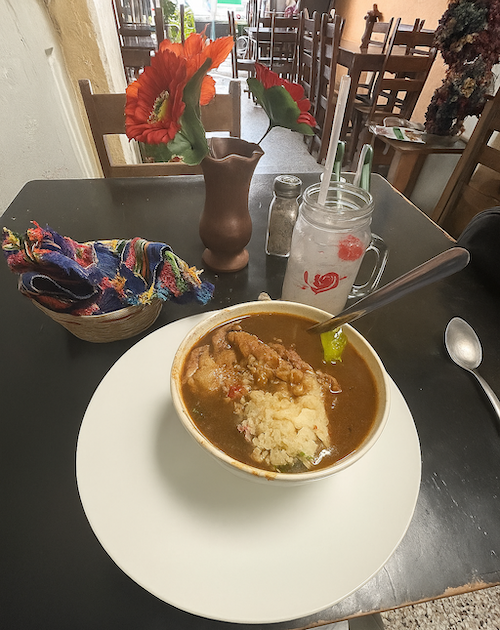
At first glance, pepián might remind you of a thick stew, and that’s partly true. But what makes it special is the deep, roasted flavor of its sauce, built from toasted spices, seeds, and vegetables. The texture is rich and velvety, clinging to each bite of meat and soaking beautifully into the rice it’s often served with.
It’s usually made with chicken or pork. Chicken is probably the most common across Guatemala, but I prefer mine with pork, especially when it’s been simmered until tender and infused with all the bold, savory flavors of the sauce. No matter the protein, the sauce is always the star.
This dish is loaded with umami thanks to the way everything is cooked. Tomatoes, onions, garlic, and dried chiles are charred or pan-roasted to bring out their deepest flavors. Sesame and pumpkin seeds are toasted until fragrant. The meat, whether pork or chicken, is seared first, giving the final dish those caramelized notes that add to its complexity. These steps create layers of flavor that build into something far more than the sum of its parts.
A Mole but Not Quite
Pepián is often compared to Mexican mole, and the comparison makes sense. Both are thick, deeply flavored sauces built from layers of roasted ingredients, spices, and seeds. Both have Indigenous roots and are still made using traditional methods passed down through generations.
But pepián is its own thing. Unlike many moles from Mexico, especially mole poblano, pepián doesn’t include chocolate. There’s no sweetness here. Instead, it leans into toasted sesame seeds (ajonjolí), pumpkin seeds (pepitoria), dried chiles like guaque or pasa, roasted tomatoes, garlic, onions, and a touch of cinnamon. I prefer using Ceylon cinnamon for its softer, more floral flavor, which blends beautifully into the sauce without overpowering the other ingredients.
The result is bold and earthy, more savory than sweet, with a slightly smoky flavor from the roasted components. While mole can come in many colors and variations, pepián stays close to its roots. It’s typically a deep reddish-brown sauce with a grainy texture from the ground seeds. Some versions may also add cloves or allspice, but the overall spice profile stays mild and balanced, not too spicy, not too sweet.
So yes, it’s a cousin of mole, but with a flavor all its own, shaped by Guatemala’s ingredients and history.
Rooted in History, Carried by Tradition
Pepián is more than just a flavorful stew. It’s one of Guatemala’s oldest dishes, with roots that stretch back to pre-Hispanic times. Long before it became the national dish, versions of pepián were already being made by the Kaqchikel and other Maya groups, using local ingredients like pumpkin seeds, chiles, and tomatoes. These ingredients were roasted, ground, and blended into thick sauces to serve with meat or vegetables, a technique that still defines the dish today.
When Spanish colonizers arrived, they brought new spices and cooking methods. Over time, these influences blended with Indigenous practices, creating the dish we now know as pepián. Cinnamon, cloves, and other warm spices were added to traditional bases, and Spanish-style stews merged with Maya flavors to form something new.
Today, pepián is recognized not only as a national favorite but also as part of Guatemala’s patrimonio cultural intangible, a designation that honors its role in the country’s cultural identity. It’s still cooked in homes across Guatemala, especially during holidays, family gatherings, or Sunday meals. And while recipes might vary from household to household, the heart of the dish remains the same: a deep respect for tradition and flavor passed from one generation to the next.
How My Family Makes It
In my extended Guatemalan family, pepián is made the traditional way. No shortcuts, no canned sauces. The process starts by roasting everything: tomatoes, onions, garlic, dried chiles, sesame seeds, and pumpkin seeds. The roasting brings out a depth of flavor that you just can’t get any other way. Once everything is charred and fragrant, it’s all blended into a thick, textured sauce that simmers with the meat until everything is rich and full of flavor.
Most families I know use chicken for pepián. It’s common and widely loved. But I prefer pork. There’s something about how pork absorbs the sauce that I find especially satisfying. The way the fat melts into the sauce gives it a richness that sticks with you in the best way. My favorite version uses bone-in pork chunks, simmered low and slow until they’re tender and practically falling apart. Here’s a link to my Pepián de Cerdo.
We always serve it with a scoop of white rice, which soaks up the sauce perfectly. And of course, there are fresh corn tortillas on the side, warm, soft, and perfect for scooping up every last bit of sauce. Potatoes, carrots, or chayote squash are normally added to the stew. I really like the chayote squash because it stands up really well to longer cooking. Some families also serve tomatillos, but for most, rice and tortillas are the ideal pairings.
Every family has its own slight twist, but the essentials stay the same: time, care, and ingredients that have been used for centuries. It’s not fancy. It’s just good, honest cooking that speaks to Guatemala’s roots.
Why Pepián Matters
Pepián isn’t just a dish. It’s a symbol of Guatemalan identity. It represents the blend of cultures that shaped the country: the ancient traditions of the Maya and the lasting influence of Spanish colonization. Every spoonful carries history, and every pot tells a story.
In many ways, cooking and sharing pepián is a form of cultural preservation. It’s a way to keep the past alive, not in a museum or textbook, but at the table, where it can be tasted, shared, and remembered. Families pass it down not just with written recipes, but through practice — by cooking together, tasting together, and teaching the next generation how to do it right.
For me, pepián is a connection to my Guatemalan family, to the time I’ve spent in Antigua, and to the rhythms of daily life there. It’s the kind of meal that fills your kitchen with the smell of toasted spices and your heart with the comfort of something familiar and meaningful.
Try It Yourself
If you’ve never had pepián before, I really encourage you to try making it. The ingredients are simple, and the process is straightforward. It just takes a little time and care. You don’t need any fancy tools or hard-to-find spices. What matters most is the attention you give each step: toasting the ingredients, blending the sauce, searing the meat, and letting it all simmer until the flavors come together.
Whether you use chicken or pork, serve it with rice or tomalitos. Fresh corn tortillas are a must. They’re the perfect companion for scooping up the rich, nutty sauce and tender meat.
I’ve shared my version of the recipe, based on how it’s made in my family. It stays true to traditional methods while using ingredients you can find in most grocery stores. I hope it brings as much comfort and flavor to your table as it does to ours.
A Dish That Stays With You
Every time I make pepián, I’m reminded of long afternoons in Antigua. The sounds of family gathered around the table, the smell of toasted seeds and chiles drifting from the kitchen, and the warmth that comes from sharing something meaningful. There’s usually laughter, a stack of fresh tortillas wrapped in a towel, and a few cold micheladas passed around as we settle in to eat. It’s not a flashy dish, but it doesn’t need to be. It’s humble, deeply flavorful, and full of history.
For me, pepián is more than just something I enjoy eating. It’s a way to stay connected to a place and a group of people I care deeply about. It’s a dish that brings my Guatemalan family to mind no matter where I am, and I hope that by sharing it, you’ll get a small taste of what makes it so special.

